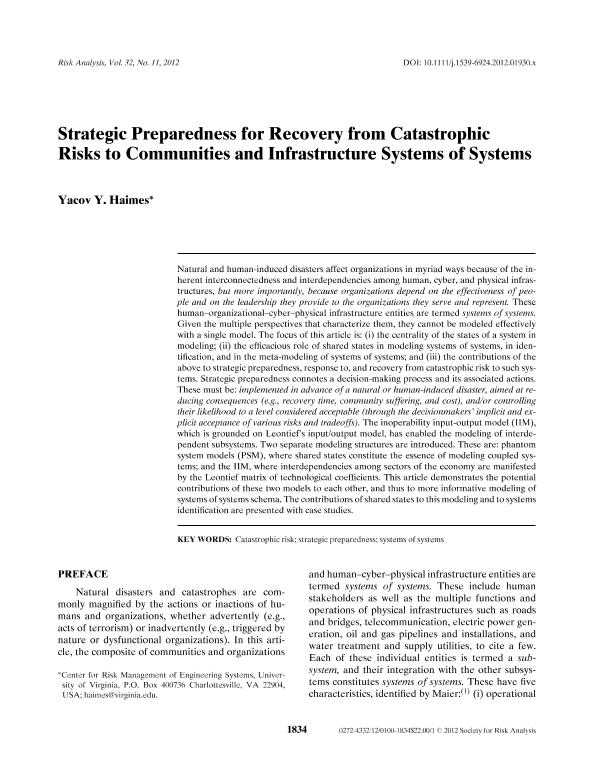Strategic preparedness for recovery from catastrophic risks to communities and infrastructure systems of systems

Contenido multimedia no disponible por derechos de autor o por acceso restringido. Contacte con la institución para más información.
| Tag | 1 | 2 | Value |
|---|---|---|---|
| LDR | 00000cab a2200000 4500 | ||
| 001 | MAP20130001968 | ||
| 003 | MAP | ||
| 005 | 20130417115809.0 | ||
| 008 | 130125e20121105esp|||p |0|||b|spa d | ||
| 040 | $aMAP$bspa$dMAP | ||
| 084 | $a7 | ||
| 100 | 1 | $0MAPA20080165192$aHaimes, Yacov Y. | |
| 245 | 1 | 0 | $aStrategic preparedness for recovery from catastrophic risks to communities and infrastructure systems of systems$cYacov Y Haimes |
| 520 | $aNatural and human-induced disasters affect organizations in myriad ways because of the inherent interconnectedness and interdependencies among human, cyber, and physical infrastructures, but more importantly, because organizations depend on the effectiveness of people and on the leadership they provide to the organizations they serve and represent. These humanorganizationalcyberphysical infrastructure entities are termed systems of systems. Given the multiple perspectives that characterize them, they cannot be modeled effectively with a single model. The focus of this article is: (i) the centrality of the states of a system in modeling; (ii) the efficacious role of shared states in modeling systems of systems, in identification, and in the meta-modeling of systems of systems; and (iii) the contributions of the above to strategic preparedness, response to, and recovery from catastrophic risk to such systems. Strategic preparedness connotes a decision-making process and its associated actions. These must be: implemented in advance of a natural or human-induced disaster, aimed at reducing consequences (e.g., recovery time, community suffering, and cost), and/or controlling their likelihood to a level considered acceptable (through the decisionmakers implicit and explicit acceptance of various risks and tradeoffs). The inoperability input-output model (IIM), which is grounded on Leontief's input/output model, has enabled the modeling of interdependent subsystems. Two separate modeling structures are introduced. These are: phantom system models (PSM), where shared states constitute the essence of modeling coupled systems; and the IIM, where interdependencies among sectors of the economy are manifested by the Leontief matrix of technological coefficients. This article demonstrates the potential contributions of these two models to each other, and thus to more informative modeling of systems of systems schema. The contributions of shared states to this modeling and to systems identification are presented with case studies. | ||
| 650 | 1 | $0MAPA20080600204$aCatástrofes naturales | |
| 650 | 1 | $0MAPA20080603960$aSistemas de detección | |
| 650 | 1 | $0MAPA20080591182$aGerencia de riesgos | |
| 650 | 1 | $0MAPA20080615277$aRiesgos de la naturaleza | |
| 650 | 1 | $0MAPA20080592059$aModelos predictivos | |
| 773 | 0 | $wMAP20077000345$tRisk analysis : an international journal$dMcLean, Virginia : Society for Risk Analysis, 1987-2015$x0272-4332$g05/11/2012 Volumen 32 Número 11 - noviembre 2012 , p. 1834-1845 |

